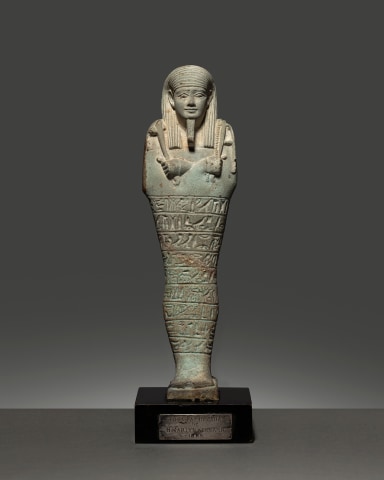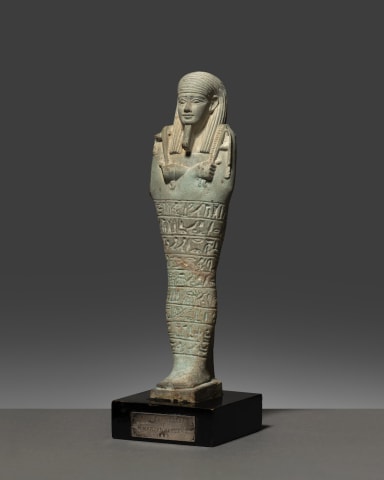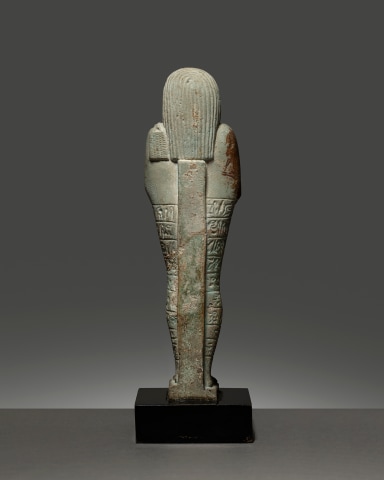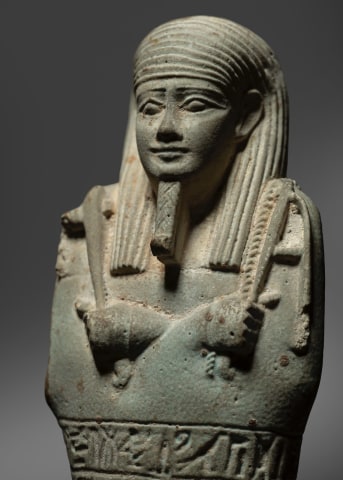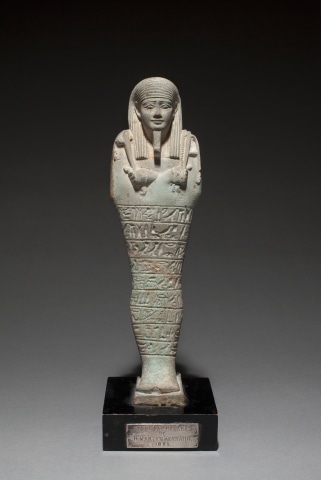Further images
Faience shabti in the name of Horoudja son of Chedit and Servant and Prophet of Neith. Mould formed, finished by hand, and with a pale blue-green glaze. Shown mummiform, as is typical, he stands on an integral trapezoidal base, and wears a striped tripartite wig, and plaited divine beard. The rather rounded face has protruding ears, slightly smiling mouth, and raised cosmetic lines around the eyes. His arms are crossed right over left with the hands protruding from a close-fitting shroud, the left holding a pick and the right a hoe and the cord to a seed bag suspended over the left shoulder, the bag is incised to imitate woven straw or rush. The dorsal column is uninscribed, and there are nine horizontal rows of incised text from Chapter Six of the Book of the Dead. Some incrustation and minor chips. Glaze somewhat worn.
Petrie discovered a total of 399 ushabtis of Horoudja at
Hawara in the Fayoum, Egypt, in 1888 in an intact tomb knee
deep in flood water: 203 were aligned in rows facing the
limestone sarcophagus with 196 found in a niche on the
opposite wall of the tomb. Described by Petrie as of the finest
quality, the various types of shabti, indicate that 17 different
moulds were used for their manufacture. There are examples in
many museums around the world including Berlin, Brussels,
Cambridge, Chicago, Copenhagen, London, New York, and
Oxford. Many of the shabtis were badly damaged by water, but
this example is better than most, with much of the surface still
showing glaze.
Petrie left a particularly graphic account of the discovery, ‘...first
one swings down a rope ladder for 25 feet, then squeezes
through the top of a doorway nearly choked, and at once slides
down the slope inside into the water. The whole of the walls are
pitch black, owing to some deposit or growth when the water has
filled the chambers. So it is very dark and the candle only just
shews where you collide with floating coffins or some skulls that
go bobbing around. One wades in carefully, the ground being
strewn with sodden wood, bones and mud... Down a well, forty
feet deep, and in a pitch-black chamber, splashing about in bitter
water, and toiling by candle-light, all the work had to be done...
While thus mining the way to the expected burial we lit on a
hole in the masonry filled with large ushabtis standing in rows,
two hundred in all, of the finest workmanship; and, before long,
on the other side of the sarcophagus, two hundred more were
found in a similar recess.’
Provenance
Henry Martyn Kennard (1833-1911), London, UK; found at Hawara 1889
B.C. Hill; acquired, 8th December 1970, lot 212
Dr A.L. Adler; sold by his Executors, 13th May 1980
Charles Bouché (1928-2010), Paris, France; acquired 1980
Karsten Schubert (1961-2019), London, UK; acquired
30th June 2014, inventory number AN86
A silver label on the front of the base reads:
FOUND AT HAWARA BY H.MARTYN KENNARD 1889
Three old paper labels on the underside of the base read:
“COLLECTION CH. BOUCHÉ. Prophète de NEITH HOROUDJAT Ne de CHEDET DYN.XXXe”
“COLLECTION CH. BOUCHÉ. Familles du PR F. Petrie á HAWARA 1890”
“Anc. Coll. Martyn Kennard - Sotheby 16 July 1912
Cat.372 - Sotheby 8/12/70 105d + fais”
Literature
Compare Jacques-F Aubert & Liliane Aubert, Statuettes égyptienne: chaouabtis, ouchebtis, (Paris, 1974) p.253, fig.154
Glenn Janes, Shabtis, a Private View, Ancient Egyptian Funerary Statuettes in European Private Collections (Paris, 2002) pp.194-197, no.99, for an example broken above the ankles
Publications
Sotheby, Wilkinson & Hodge, London, UK, Catalogue of the Important Collection of Egyptian Antiquities Formed by the Late H. Martyn Kennard of Lowndes Square, 16th-19th July 1912, lot 372Sotheby & Co, London, UK, Catalogue of Egyptian, Western Asiatic, Greek and Roman Antiquities, 8th December 1970, lot 212
Sotheby Parke Bernet & Co, London, UK, Ancient Glass, Middle Eastern, Egyptian, Greek, Roman and Etruscan Antiquities, 13th May 1980, Lot 119
